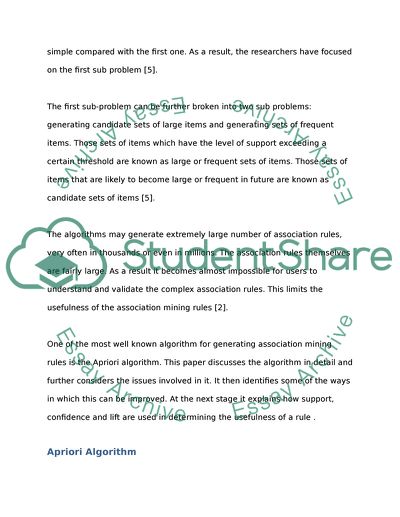Cite this document
(Association Rule Mining - Apriori Algorithm Case Study, n.d.)
Association Rule Mining - Apriori Algorithm Case Study. Retrieved from https://studentshare.org/logic-programming/1553409-discuss-the-issues-with-the-basic-a-priori-algorithm-for-association-rule-mining-and-the-some-of-the-various-ways-that-it-can-be-improved-also-explain-how-support-confidence-and-lift-are-used-to-determine-the-usefulness-of-a-rule
Association Rule Mining - Apriori Algorithm Case Study. Retrieved from https://studentshare.org/logic-programming/1553409-discuss-the-issues-with-the-basic-a-priori-algorithm-for-association-rule-mining-and-the-some-of-the-various-ways-that-it-can-be-improved-also-explain-how-support-confidence-and-lift-are-used-to-determine-the-usefulness-of-a-rule
(Association Rule Mining - Apriori Algorithm Case Study)
Association Rule Mining - Apriori Algorithm Case Study. https://studentshare.org/logic-programming/1553409-discuss-the-issues-with-the-basic-a-priori-algorithm-for-association-rule-mining-and-the-some-of-the-various-ways-that-it-can-be-improved-also-explain-how-support-confidence-and-lift-are-used-to-determine-the-usefulness-of-a-rule.
Association Rule Mining - Apriori Algorithm Case Study. https://studentshare.org/logic-programming/1553409-discuss-the-issues-with-the-basic-a-priori-algorithm-for-association-rule-mining-and-the-some-of-the-various-ways-that-it-can-be-improved-also-explain-how-support-confidence-and-lift-are-used-to-determine-the-usefulness-of-a-rule.
“Association Rule Mining - Apriori Algorithm Case Study”. https://studentshare.org/logic-programming/1553409-discuss-the-issues-with-the-basic-a-priori-algorithm-for-association-rule-mining-and-the-some-of-the-various-ways-that-it-can-be-improved-also-explain-how-support-confidence-and-lift-are-used-to-determine-the-usefulness-of-a-rule.


